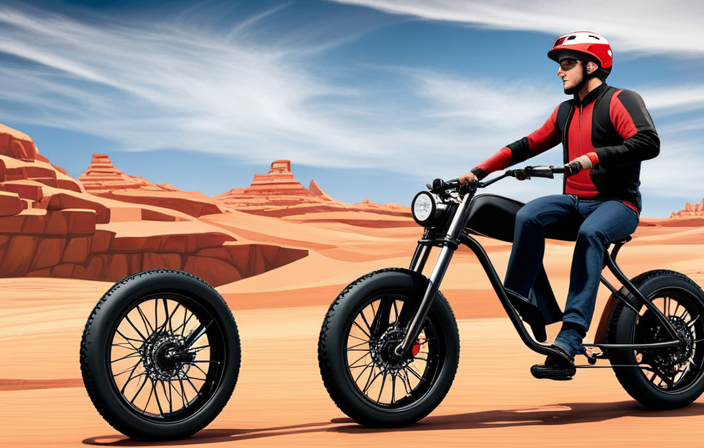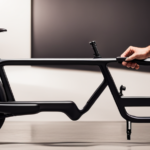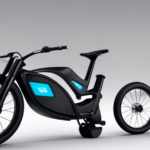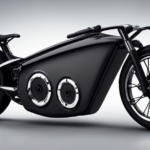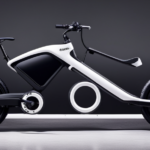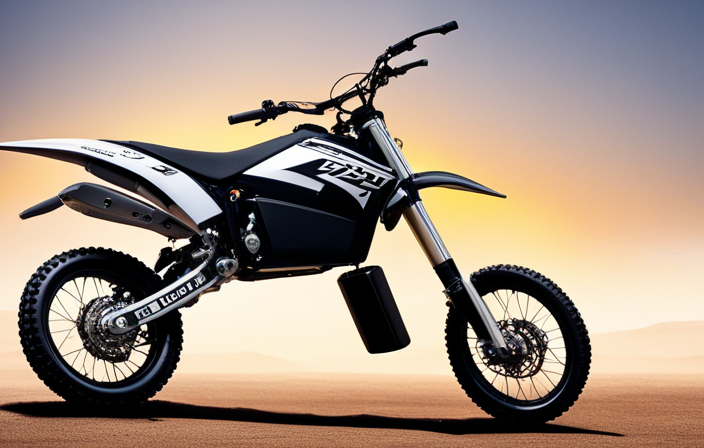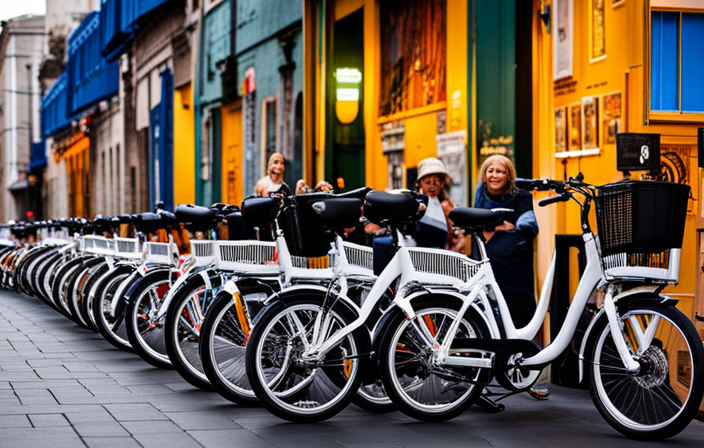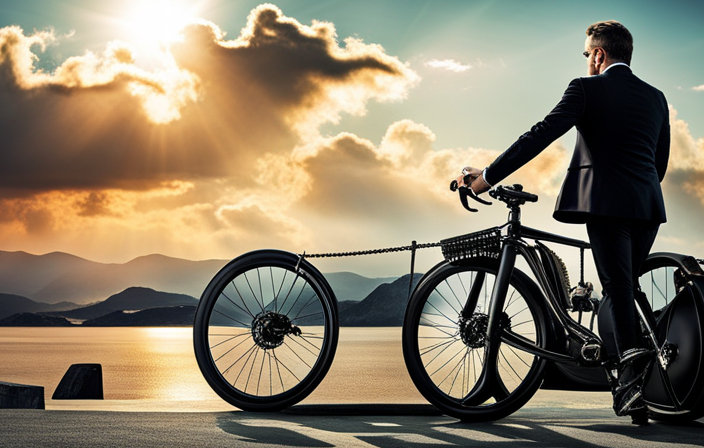Have you ever thought about which **size motor and battery** to use for your electric bike? Stick around, and I’ll give you all the **info** you need to choose wisely. Trust me, you won’t want to miss out on this helpful insight!
In this article, we will delve into determining your riding needs, choosing the right motor size, considering battery capacity, evaluating battery chemistry, assessing battery management systems, and budget and cost considerations.
Let’s dive in and find the perfect motor and battery for your electric bike.
Key Takeaways
- Battery protection features such as overcharge protection, cell balancing, and thermal protection are important to prevent battery damage and ensure optimal performance.
- Compatibility between the Battery Management System (BMS) and motor is crucial for maximizing power delivery and extending battery life.
- Proper installation and maintenance, including securing components, checking electrical connections, and regular inspections, are necessary for smooth operation.
- When considering the size of the motor and battery for an electric bike, seeking expert advice, testing and experimenting with different sizes, and analyzing test results are recommended.
Determine Your Riding Needs
To determine your riding needs, you’ll need to consider factors such as terrain, distance, and desired speed. The battery life and power output are crucial aspects to consider when choosing the right motor and battery for your electric bike.
Battery life refers to how long the battery can last on a single charge, while power output measures the motor’s ability to deliver power to the bike. If you plan on riding long distances or tackling hilly terrains, a larger battery with a longer battery life and higher power output would be ideal.
On the other hand, if you’re mainly using your electric bike for short commutes or flat terrains, a smaller battery with a shorter battery life and lower power output may suffice.
Now that we’ve considered our riding needs, let’s move on to choosing the right motor size.
Choose the Right Motor Size
Selecting the proper motor and battery is essential for your e-bike. When it comes to choosing the right motor size, there are a few factors to consider.
Firstly, determine the motor power you need based on your riding style and terrain. If you plan on riding mostly on flat roads, a smaller motor size may be sufficient. However, if you anticipate riding on hilly or uneven terrain, a larger motor size would be more suitable.
Additionally, take into account your weight and the weight of any cargo you may be carrying. A heavier load may require a more powerful motor. Finally, consider the speed you want to achieve. A higher speed may require a larger motor size.
By carefully considering these factors, you can choose the appropriate motor size for your e-bike.
Now let’s discuss the next aspect to consider: battery capacity.
Consider Battery Capacity
When it comes to choosing the right battery for your electric bike, there are a few key factors to consider.
First, you’ll need to calculate the energy requirements based on your riding needs. This will help determine the capacity of the battery you’ll need.
Additionally, you’ll want to determine the voltage and amp-hour rating that is suitable for your bike.
Calculate the energy requirements based on your riding needs
Calculate how much energy you’ll need for your riding needs based on your desired distance and speed. To determine the energy requirements for your electric bike, you should consider the riding distance and power output. The table below provides a breakdown of the energy requirements based on different riding distances and power outputs:
| Riding Distance (miles) | Power Output (watts) | Energy Requirements (watt-hours) |
|---|---|---|
| 10 | 250 | 2500 |
| 20 | 350 | 7000 |
| 30 | 500 | 15000 |
| 40 | 750 | 30000 |
Determine the voltage and amp-hour rating you need
To figure out the appropriate voltage and amp-hour rating, you’ll want to consider the energy requirements and make sure they align with the specifications of available options. Here’s how to determine the power requirements and select the appropriate battery:
-
Calculate your energy needs: Assess how far and how fast you plan to ride, as well as the terrain you’ll be traversing. This will help you estimate the amount of power required.
-
Research battery options: Look for batteries with voltage and amp-hour ratings that match your power requirements. Consider lithium-ion batteries, which are lightweight and provide high energy density.
-
Consider battery lifespan: Take into account the number of charge cycles a battery can handle before its capacity starts to degrade. Opt for a battery with a longer lifespan if you plan to use your electric bike frequently.
-
Budget and weight: Compare the cost and weight of different battery options. Choose one that fits your budget and doesn’t add excessive weight to your bike.
By determining the power requirements and selecting the appropriate battery, you can ensure optimal performance for your electric bike.
Now, let’s consider the weight and size of the battery.
Consider the weight and size of the battery
Consider the weight and dimensions of the battery to ensure it fits properly on your e-bike. The battery weight and size are crucial factors to consider when choosing the right battery for your electric bike. Not only do you want a battery that will fit securely on your bike, but you also want one that won’t add excessive weight and affect your bike’s performance. To give you an idea of the range of battery weights and sizes available, here is a table showcasing some common options:
| Battery Model | Weight (lbs) | Dimensions (inches) |
|---|---|---|
| A | 5 | 10x5x3 |
| B | 7 | 12x6x4 |
| C | 10 | 14x7x5 |
| D | 12 | 16x8x6 |
| E | 15 | 18x9x7 |
Evaluate Battery Chemistry
When choosing a battery for your electric bike, you’ll want to think about the different chemistry options available. The battery chemistry you choose will greatly impact the battery life and charging options for your electric bike.
One popular choice is the lithium-ion battery, known for its high energy density and long lifespan. These batteries offer a good balance between weight and capacity, making them ideal for electric bikes.
Another option is the nickel-metal hydride (NiMH) battery, which has a lower energy density than lithium-ion but is more affordable.
It’s important to consider the charging options for each battery chemistry as well. Some batteries may require specific charging equipment or longer charging times.
Assessing the battery management system is the next step in ensuring optimal performance for your electric bike.
Assess Battery Management System
When choosing a battery for your electric bike, it’s crucial to consider the battery management system. Look for a battery with a reliable management system that will efficiently monitor and protect the battery.
Features like thermal protection and overcharge protection are important to ensure the safety and longevity of the battery. Additionally, make sure that the battery management system is compatible with your motor to ensure optimal performance.
Look for a battery with a reliable management system
To ensure your electric bike runs smoothly, make sure you find a battery with a reliable management system. The battery management system (BMS) is an essential component that monitors and controls the battery’s performance and lifespan. It ensures the battery operates within safe limits and maximizes its efficiency.
When looking for a battery with a reliable BMS, consider the following:
-
Thermal Protection: A good BMS should have thermal protection features to prevent the battery from overheating. This not only extends the battery’s lifespan but also ensures your safety during rides.
-
Overcharge Protection: Another important feature to consider is overcharge protection. A reliable BMS will prevent the battery from overcharging, which can lead to battery damage or even fire hazards.
-
Cell Balancing: A BMS with cell balancing functionality helps ensure that each individual cell within the battery pack is charged and discharged evenly. This helps to maintain optimal battery performance and prolong its lifespan.
When choosing an electric bike battery, it’s crucial to consider features like thermal protection and overcharge protection to ensure the safety and longevity of your battery.
Consider features like thermal protection and overcharge protection
A reliable BMS should have features like thermal protection and overcharge protection to ensure the safety and longevity of your electric bike battery. Thermal protection is crucial because it prevents the battery from overheating, which can lead to damage or even fire. Overcharge protection, on the other hand, prevents the battery from being charged beyond its safe limit, which can also cause damage and reduce the battery’s lifespan. To help you understand the importance of these features, here is a table showcasing the benefits they provide:
| Feature | Thermal Protection | Overcharge Protection |
|---|---|---|
| Safety | ✓ | ✓ |
| Battery Longevity | ✓ | ✓ |
| Prevention of Damage | ✓ | ✓ |
| Fire Prevention | ✓ |
Ensure the battery management system is compatible with your motor
Make sure the BMS is compatible with your motor for optimal performance and to avoid any potential issues.
The battery management system (BMS) plays a crucial role in ensuring the efficiency and longevity of your electric bike’s motor and battery. It acts as the brain of the system, monitoring and regulating the flow of power to the motor.
Ensuring compatibility between the BMS and motor is essential to maximize efficiency. A mismatched BMS can result in reduced performance, decreased battery life, and even potential damage to the motor. By choosing a BMS that is specifically designed for your motor, you can ensure that the power delivery is optimized, resulting in improved overall performance.
So, when selecting a BMS, always consider its compatibility with your motor to achieve the best motor and battery efficiency.
Speaking of efficiency, another important factor to consider is the installation and maintenance of your electric bike’s components.
Consider Installation and Maintenance
Installing and maintaining an electric bike requires regular check-ups and occasional repairs. When it comes to installation, there are a few tips to keep in mind.
- Ensure that all components are properly aligned and securely fastened. This will help prevent any unnecessary vibrations or rattling.
- Double-check all electrical connections and make sure they are tight and free from any damage.
As for maintenance, having a checklist can be helpful.
- Regularly inspect the tires for wear and tear.
- Check the brakes for proper function.
- Clean the chain and gears to keep them running smoothly.
- Periodically check the battery charge level and ensure it is properly stored and maintained.
By following these installation tips and maintenance checklist, you can keep your electric bike in optimal condition.
Now let’s move on to budget and cost considerations.
Budget and Cost Considerations
To save money on your electric bike, you might consider purchasing a used model from a reputable seller. Here are some budget and cost considerations to keep in mind:
-
Affordability and pricing options:
-
Look for deals and discounts: Many sellers offer promotions or discounts on used electric bikes, allowing you to get a quality bike at a lower price.
-
Compare prices: Research different sellers to find the best price for the specific model you’re interested in.
-
Consider financing options: Some sellers offer financing plans that allow you to pay for your electric bike in installments, making it more affordable upfront.
-
Long term cost savings and return on investment:
-
Energy efficiency: Electric bikes are more fuel-efficient than traditional bikes, saving you money on fuel costs in the long run.
-
Reduced maintenance: Compared to gas-powered vehicles, electric bikes have fewer moving parts, resulting in lower maintenance and repair costs.
-
Increased resale value: Quality electric bikes hold their value well, so when it’s time to upgrade, you can sell your used bike for a good price.
Considering these factors can help you make a financially smart decision when purchasing an electric bike. However, it’s important to seek expert advice to ensure you choose the right motor and battery size for your specific needs.
Seek Expert Advice
If you’re unsure about which electric bike is right for you, it’s a good idea to seek expert advice. When it comes to finding the perfect motor and battery size for your electric bike, consulting professionals can provide valuable recommendations. There are many factors to consider, such as your riding style, terrain, and desired range. Experts can take these factors into account and help you make an informed decision. They have the knowledge and experience to guide you towards the right motor power and battery capacity that will meet your specific needs. By seeking their advice, you can ensure that your electric bike performs optimally and provides you with an enjoyable riding experience. With their expertise, you can make a more confident choice when it comes to selecting the right motor and battery size for your electric bike.
Transitioning into the next section about ‘test and experiment,’ it’s important to note that while seeking expert advice is crucial, it is also beneficial to test and experiment with different motor and battery sizes. By trying out different combinations, you can find what works best for you and fine-tune your electric bike to your preferences.
Test and Experiment
When you try out and experiment with different combinations, you can discover the optimal setup for your electric bike. Testing different motor and battery sizes will provide valuable insights into their performance and help you make an informed decision.
Here are two sub-lists to guide you in your tests:
-
Motor Size:
-
Start with a smaller motor and gradually increase its size to observe the impact on speed and torque.
-
Measure the test results, including acceleration, top speed, and range, for each motor size.
-
Battery Size:
-
Begin with a basic battery capacity and then upgrade to larger ones to assess the impact on distance and overall performance.
-
Analyze the test results, considering factors like range, charging time, and weight, for each battery size.
Make an Informed Decision
By analyzing different combinations and conducting tests, I can make an informed decision about the optimal setup for my electric bike.
When evaluating battery technology, it’s important to consider factors such as capacity, voltage, and weight. Higher capacity batteries will offer longer range, while higher voltage batteries can provide more power. However, it’s crucial to balance this with the weight of the battery, as a heavier battery can affect the bike’s performance.
When comparing motor efficiency, I look at factors such as power output, torque, and energy consumption. A more efficient motor will convert more electrical energy into mechanical power, resulting in better performance and longer battery life.
Frequently Asked Questions
How do I determine the specific power requirements for my electric bike based on my weight and the terrain I will be riding on?
To determine the specific power requirements for your electric bike, analyze your weight and the terrain you’ll be riding on. Consider your weight as it affects the load on the motor and battery, and evaluate the terrain for inclines and resistance.
What are the advantages and disadvantages of different battery chemistries, such as lithium-ion, lead-acid, and nickel-metal hydride, in terms of performance, lifespan, and cost?
Lithium-ion batteries have advantages in electric bikes: high energy density, light weight, and longer lifespan. Lead-acid batteries are cheaper but heavier, while nickel-metal hydride batteries offer a balance between cost and performance.
Are there any specific maintenance requirements for electric bike motors and batteries, and how often should they be performed?
Maintenance frequency for electric bike motors and batteries varies depending on usage. Regular maintenance includes cleaning, lubricating, and inspecting for damage. Troubleshooting techniques involve checking connections, voltage levels, and consulting the manufacturer’s guide for specific issues.
Can I upgrade the motor or battery capacity of my electric bike in the future, or do I need to choose the right size from the beginning?
Yes, it is possible to upgrade the motor or battery capacity of an electric bike in the future. This provides flexibility and allows for customization based on individual needs and preferences. It is important to consider long-term investment when choosing the right size initially.
What are some common mistakes or pitfalls to avoid when choosing a motor and battery for an electric bike, and how can I ensure I make the best decision for my needs?
Common misconceptions when choosing a motor and battery for an electric bike include overlooking the impact of size on range. To make the best decision, consider factors such as terrain, weight, and desired speed.
Conclusion
In conclusion, finding the right motor and battery for your electric bike is crucial for optimal performance.
As I embarked on my own journey to choose the perfect components, I realized that it’s not just about power and capacity. It’s about understanding your riding needs, considering battery chemistry, and assessing the management system.
It’s like building a symphony, where each instrument plays a vital role in creating harmonious music.
So, take your time, seek expert advice, and test different options until you find the perfect combination that will propel you towards an electrifying ride.
